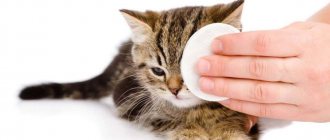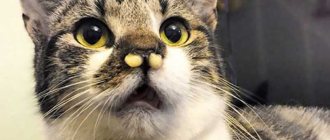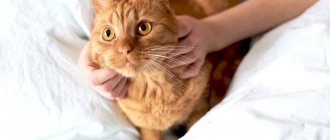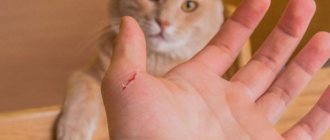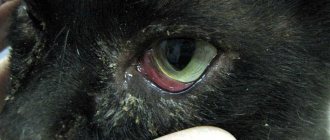- Lethargy of the animal.
- Refusal of food and water.
- Prolonged bouts of vomiting.
- Continuous diarrhea.
- Constipation.
- Signs of intestinal obstruction.
- The cat does not have any alarming symptoms associated with swallowing the bag, but it does have internal diseases that you are aware of.
You can’t hesitate and rely on the fact that the cat will feel better! When visiting a medical veterinary institution, the animal will undergo a set of procedures that will help determine the degree of danger and determine further treatment actions. The cat should have an ultrasound, x-ray or study with a contrast agent. Polyethylene is dangerous with the risk of developing severe intestinal obstruction. Situations when surgical intervention are necessary are not uncommon. Rehabilitation after surgery is quite difficult and lengthy.
Another difficult moment for a cat is anesthesia . If there are concomitant diseases (heart, stomach, liver, kidneys), doctors do not give any guarantees and in the postoperative period you should rely only on the cat’s strength. Also at risk are cats whose age exceeds 7 years. The situation can be significantly aggravated by a late visit to the clinic and a high risk of developing intestinal tissue necrosis.
Most likely, the pet will be prescribed maintenance therapy and a special diet. If you value your pet and wish him a full recovery, doctors’ recommendations should be followed completely and without making independent adjustments.
To worry or not
Representatives of the cat family in natural conditions tend to “cleanse” the stomach and intestines with inedible objects. Therefore, you should not be surprised when your pet begins to show an unhealthy interest in Christmas tree “rain”, plastic bags or packaging for meat and fish products.
Wrong diet.
Most often, this phenomenon indicates that the cat is simply hungry or lacks the vitamins that it is trying to obtain in such a unique way.
In this case, you can start feeding your furry pet with specialized food, sprouted grass or soft chicken bones.
If changing the diet does not help and the cat continues to eat inedible objects, you should carefully observe changes in his behavior and condition. Even a small piece of polyethylene that gets into the stomach of an animal can cause a stop or slowdown in the movement of feces through the intestines with simultaneous blockage of its lumen (coprostasis) and intestinal obstruction.
Other reasons. The following may indicate the tabby's fascination with inedible packaging:
- stress – eating bags helps the animal get rid of the discomfort;
- intestinal diseases, toothache or oral problems.
Separately, it should be noted that a piece of polyethylene can get into the stomach during play or even in order to attract the owner’s attention. If the piece eaten was small, smaller in size than a matchbox, most likely there is no cause for concern; it will come out on its own with feces or vomit within a few hours. If this does not happen or the package is not all out, and the pet’s condition begins to deteriorate, this is a reason to immediately contact a veterinarian.
If the cat ate the bag: what to do and should you worry?
All felines are quite curious animals. Cats are especially interested in all kinds of boxes and bags. Sometimes the study of these objects can be particularly dangerous for the animal. For example, a cat may eat a plastic bag just out of interest or if it smells like food.
What to do if a cat eats plastic?
There are a great many situations when cats feast on absolutely inedible human objects. Even the most calm, well-mannered and well-fed cats will not miss the opportunity to eat a bag containing food, and plastic labels from sausages and fish products are no exception.
So, the pet has already eaten the whole bag or bit off a piece from it and is chewing it deliciously... The owner in such a situation should first of all calm down and pull himself together .
All your pet needs at the moment is close attention, as well as monitoring his behavior and well-being. There is a high probability that the foreign body will naturally leave the cat’s body. It is worth observing for three to four days.
If during this time the cat’s behavior has not changed, the animal is active and eats with a good appetite, there is nothing to worry about.
When is veterinary help needed?
If within 72 hours you notice any discomfort in your animal, you should definitely consult a doctor. Warning symptoms include:
- Lethargy of the animal.
- Refusal of food and water.
- Prolonged bouts of vomiting.
- Continuous diarrhea.
- Constipation.
- Signs of intestinal obstruction.
- The cat does not have any alarming symptoms associated with swallowing the bag, but it does have internal diseases that you are aware of.
You can’t hesitate and rely on the fact that the cat will feel better! When visiting a medical veterinary institution, the animal will undergo a set of procedures that will help determine the degree of danger and determine further treatment actions.
The cat should have an ultrasound, x-ray or study with a contrast agent. Polyethylene is dangerous with the risk of developing severe intestinal obstruction. Situations when surgical intervention are necessary are not uncommon.
Rehabilitation after surgery is quite difficult and lengthy.
Another difficult moment for a cat is anesthesia .
If there are concomitant diseases (heart, stomach, liver, kidneys), doctors do not give any guarantees and in the postoperative period you should rely only on the cat’s strength.
Also at risk are cats whose age exceeds 7 years. The situation can be significantly aggravated by a late visit to the clinic and a high risk of developing intestinal tissue necrosis.
Most likely, the pet will be prescribed maintenance therapy and a special diet. If you value your pet and wish him a full recovery, doctors’ recommendations should be followed completely and without making independent adjustments.
Absolutely forbidden!
If you notice that a cat has swallowed polyethylene, then under no circumstances should you help him get rid of it.
You should not give your animal drugs that cause vomiting or laxatives; the notorious Vaseline oil for cats is also highly taboo! This can significantly aggravate the situation and harm the cat.
If you deliberately induce vomiting in a cat, there is a high probability of the bag getting stuck in the throat and, as a result, suffocation of the animal.
All laxatives and oils are dangerous because in case of intestinal obstruction, under their influence the intestines will become even more clogged and the pet’s condition will worsen. Self-therapy and attempts to alleviate the cat’s condition with intuitively selected medications, in many cases, end in an emergency visit to the veterinary clinic and the possibility of surgery.
If you are one of the lucky ones and everything is fine with the cat after such a feast, you shouldn’t rejoice ahead of time either. There is a possibility that when trying to go to the toilet, the animal may get this same polyethylene stuck in its anus.
Under such circumstances, you should also not “help” the cat on your own. You should not try to pull on a piece of the bag that is visible to you; you can damage the mucous membrane and gastrointestinal tract of your pet.
It is better to contact a specialist who, using special devices, will painlessly and quickly remove the foreign body from the rectum.
First aid
The surface of the tongue in cats has special papillae that are curved towards the esophagus. Because of this, they cannot get rid of the package that got inside. But under no circumstances should a person try to remove the bag from the cat’s body on their own. Any mechanical impact on the part of the owner can lead to damage to the intestinal walls or suffocation. The most that an owner can do at home is:
- Give the animal plenty of water to induce vomiting.
- To liquefy feces and facilitate the passage of a foreign body through the gastrointestinal tract, you can give your pet Vaseline oil.
- If a piece of packaging from a toxic substance is eaten, activated carbon or another adsorbent can be given along with a large amount of water to weaken the effect of the poison on the body.
It is important to remember that any first aid does not exclude consultation with a veterinarian. After all, it is unknown how many and what size pieces of polyethylene the cat swallowed.
When urgent veterinary care is needed. It is urgently recommended to take your pet to a veterinary clinic if:
- vomiting that does not stop for several hours;
- constant diarrhea or, conversely, constipation;
- changed behavior of the pet, restless meowing;
- licking the belly or rolling on the floor;
- swollen and painful stomach;
- lack of appetite;
- bloody vomit and feces;
- lethargy and apathy.
If such symptoms do not stop for a long time or appear 2-3 days after eating the bag, this is a serious reason to contact a veterinarian.
Preventive measures
If a kitten or cat appears in your house, then you need to know what to do so that it does not eat the fish along with the cellophane.
- Do not throw away the skins of sausages, sausages, bags in which fish or meat was stored in places accessible to the cat. Keep trash bags out of your cat's reach. To prevent your cat from eating the skin of a hot dog or sausage, throw it away in a special bag that will be stored in an inaccessible place. Store used cat food bags there too;
- If there is a Christmas tree in the room, keep an eye on your pet. To prevent the kitten from eating the rain and tinsel, hang it high from the floor, do not let him play with it;
- Remove ribbons and threads, especially knitting ones, so that the cat does not eat them, especially if the day before you noticed that he ate a rag or paper;
- Do not allow the cat to eat a bag that smells of valerian, or blisters for sedatives that contain this herb. Cats often lick things that have come into contact with valerian and can swallow them.
We suggest you read: At what age do puppies of small and large breeds change their baby teeth?
Remember that your pet's health is in your hands. And his well-being, and in some cases his life, will depend on your vigilance and attentiveness.
Source
Diagnosis and treatment
When contacting a veterinarian, you need to describe all the symptoms, and also provide information about concomitant diseases and the age of your furry pet. Most likely, the doctor will prescribe an x-ray and ultrasound to determine the location and size of the swallowed piece, as well as to rule out intestinal obstruction. If the diagnosis is not confirmed, the sick animal will be prescribed a diet consisting of abundant, dense food. Under its pressure, the foreign substance will move through the intestines without injuring it.
Purpose of the operation. In particularly severe cases, surgery may be required, for example:
- in case of untimely access to a veterinary hospital;
- if x-ray showed intestinal obstruction;
- Too large a piece of polyethylene has been swallowed.
Who takes the most risks?
At risk are animals older than 7 years and those suffering from heart, liver, and kidney diseases.
Due to the fact that developing necrosis (tissue death) can affect other organs, the veterinarian may order an additional study - x-ray with a contrast agent - to determine the boundaries and structure of the affected tissues.
In addition, as cats age, it becomes more difficult for them to tolerate anesthesia, and the owner must be prepared for any outcome. Quite often, most pet deaths occur due to late contact with a specialist.
Also watch the video on what to do if a kitten ate a needle, thread, or bag:
Why does a cat eat cellophane and what to do in this case?
The cat really loves to eat packaging bags, tears them to shreds and eats them, even pulls them out of the bag, maybe she lacks some vitamins?
Most often, eating plastic bags is a bad habit formed while living on the street. This behavior is typical for selected cats and can only be combated by hiding the bags from the cat. Sometimes behavioral disorders also occur in initially domestic, “prosperous” cats, as a response to stress or a consequence of dysbiosis. In this case, it is recommended to eliminate factors that are traumatic to the cat’s psyche, if any, and drink 1 ml of Biovestin for a month. 2 times a day to restore normal intestinal microflora.
What to do if the cat ate the bag?
Is this situation dangerous for his life or health or not and is it worth contacting a veterinarian? Here's what modern experts write about it.
Should I worry?
From time to time, cats may eat sausage rinds, Christmas tree decorations, or bags containing meat or fish products. If the piece of polyethylene is small, then there is nothing wrong with that. It leaves the body on day 3-4 along with feces, without causing significant harm to the animal.
Under natural conditions, cats can eat non-food fibers, which they use to cleanse their stomachs, so it is not surprising that they chew rags, bags and inedible things.
Veterinarians advise that if cats start eating bags, bring them grass that has not been treated with chemicals, soft chicken bones or special solid food for animals, which is best selected together with a veterinarian.
Even if a cat, like a dog, eats a large inedible object, it will vomit it. It will not penetrate the intestines and will help the animal cleanse its stomach. It is worth observing the behavior of the animal for 3-4 days.
If it hasn't changed, there's nothing to worry about.
But if after eating the package you notice the following symptoms, you should immediately contact the clinic, even if the cat ate a small piece of cellophane:
- restless meowing, excitement. The cat begins to fuss and bother the owners, which has not been observed before;
- constipation, the cat cannot go to the toilet;
- The belly is enlarged, but the cat won’t let me touch it. In some cases, the animal begins to constantly lick its belly or roll on the floor;
- persistent vomiting and lack of appetite;
- constant diarrhea;
- lethargy, apathy and refusal to eat.
Even if the cat ate a small piece, the symptoms described above may indicate intestinal obstruction or a foreign object in the body that requires urgent intervention from a specialist. If no measures are taken, the animal may die.
Therefore, at home it is dangerous to give a cat a laxative or try to induce vomiting. A cat can eat a plastic bag along with its contents.
In this situation, the likelihood of intestinal obstruction is reduced, but rough parts from the food bag can injure the intestines and cause alarming symptoms.
What will the doctor advise?
Even an ordinary Christmas tree ribbon can be deadly for a cat who decides to play with it. The material from which it is made may be more dangerous than polyethylene and cause severe intestinal obstruction, but the most dangerous are considered to be Christmas tree rain, ribbons for Christmas decorations, foil or rough paper.
Therefore, for safety reasons, do not leave your cat unattended where there is a Christmas tree or bags of food or leftover food. If the cat has eaten cellophane, do not try to remove it completely, as this may damage the esophagus or a piece of cellophane will get stuck in the throat and may cause suffocation.
You should not give a laxative, as it will worsen the effect; consult a veterinarian.
After examining the cat, he will prescribe an ultrasound and x-ray. These studies will help determine the localization of polyethylene and the general condition of the cat’s body . In some cases, a study with a contrast agent is required. If the animal has a severe case and necrosis of intestinal tissue has begun, surgical intervention will be required.
If there are underlying medical conditions or if the cat is over 7 years old, this can be very risky, so it is worth preparing for any outcome. If the x-ray does not confirm intestinal obstruction, and the foreign body does not injure the internal organs, the doctor will most likely prescribe a diet.
The cellophane will come out along with the stool.
If the package is stuck in the intestines, a rich and dense diet is required. Under no circumstances should you try to interfere with this process on your own, especially if the cat has eaten a large piece of a plastic bag.
In this situation, it is better to contact a veterinarian. Even if a string is stuck in your cat's intestines, do not remove it as it may damage the intestines.
It can pass out of the cat’s body with feces on its own, or this will require the intervention of a specialist.
Preventive measures
If a kitten or cat appears in your house, then you need to know what to do so that it does not eat the fish along with the cellophane..
- Do not throw away the skins of sausages, sausages, bags in which fish or meat was stored in places accessible to the cat. Keep trash bags out of your cat's reach. To prevent your cat from eating the skin of a hot dog or sausage, throw it away in a special bag that will be stored in an inaccessible place. Store used cat food bags there too;
- If there is a Christmas tree in the room, keep an eye on your pet. To prevent the kitten from eating the rain and tinsel, hang it high from the floor, do not let him play with it;
- Remove ribbons and threads, especially knitting ones, so that the cat does not eat them, especially if the day before you noticed that he ate a rag or paper;
- Do not allow the cat to eat a bag that smells of valerian, or blisters for sedatives that contain this herb. Cats often lick things that have come into contact with valerian and can swallow them.
Remember that your pet's health is in your hands. And his well-being, and in some cases his life, will depend on your vigilance and attentiveness.
Source
Source: https://sovkus.ru/pozitiv/pochemu-kot-est-cellofan-i-chto-v-takom-sluchae-delat.html
What to do if a cat ate a thread?
Any inedible object eaten by a cat threatens it with two dangers - intestinal obstruction and perforation. If a cat has eaten a non-sharp, small or biodegradable object (a piece of paper, a raw bone, a fruit seed, a coin, a button, a cotton swab, etc.), then most likely it will come out on its own naturally.
Immediate medical attention is required if a cat swallows string tape (the intestines can collect on them), boiled bones, needles, pins, tinsel, other foil products (intestinal perforation), as well as any large quantities of objects, including litter (intestinal obstruction). If you get to the veterinarian in time, then everything can be done with endoscopic removal of the object from the stomach, if not, you cannot do without surgery.
To the question “what to do if the cat ate something wrong,” there is only one answer - show it to the veterinarian. It definitely won’t be unnecessary, and in many cases a timely visit to the clinic can save a cat’s life!
What to do if your cat ate a crocus?
Eating indoor and garden plants and the owner's bouquets is one of the cat's favorite pastimes. And, unfortunately, it is quite risky, since many potted and cut flowers are poisonous to animals.
The most dangerous for cats are all bulbous plants (tulips, crocuses, irises, lilies), all euphorbias, crushed seeds of some rosaceous plants (apricot, plum, apple, peach, etc.), as well as aloe, kalanchoe, monstera, aconite, delphinium and many others. Bulbous plants poison even the water in which they stand, so most often tragic cat poisonings are associated with them.
If you see that your cat is chewing any indoor, garden or bouquet plant, urgently check the lists of poisonous vegetation, and if you find yours there, immediately run to the veterinarian. In most cases, the count is in minutes and hours.
READ Pigeons made a nest on the balcony, what to do
To avoid this, isolate bouquets from the cat, and distribute all dangerous indoor plants to friends.
What to do if a cat ate a mouse?
All “natural” birds, mice, reptiles and amphibians that are prey for cats are always infected with a large number of different parasites. Therefore, cats with access to such prey should be treated for fleas and ticks every month, and also once a quarter for worms. In addition, they must be vaccinated and periodically examined by a veterinarian for the presence of protozoa, blood parasites, other parasites and diseases.
READ Dandruff in cats on the back and around the tail: causes and treatment, what to do
Another serious danger for cats is poisoned mice. Today, poisons of various effects are used to kill rodents. It is very difficult for a non-professional to determine from the symptoms what exactly poisoned the mouse and the cat that ate it. Therefore, if you suspect poisoning with rat poison, the cat should be immediately taken to the veterinarian.
What not to do if your cat vomits after swallowing a foreign object!
- If vomiting increases, you should not give him food or drink. This is due to the fact that substances in this state of the body will not be absorbed, and the vomiting process will only intensify, which will further dehydrate the animal’s body.
- Perform an enema. The pressure of water can create additional pressure on the intestinal walls, which threatens rupture.
- Give a laxative. This also threatens the animal with rupture of the tissues of internal organs.
- Avoid taking antiemetic medications. They will only relieve the symptom and can mask the disease for some time that will be lost.
- Hoping that it will go away on its own. Don’t waste time, the sooner the animal falls into experienced hands, the faster it will be cured.
READ What to do if your pug's eye falls out
Even after the “accident,” your pet continues to eat inedible objects. Perhaps he has a disease - picanism. Scientists say that it occurs against the background of a lack of attention, education and boredom of the animal or a lack of any elements in the diet. A loving owner will always find a way out of this situation by organizing proper nutrition and leisure for his four-legged friend.




